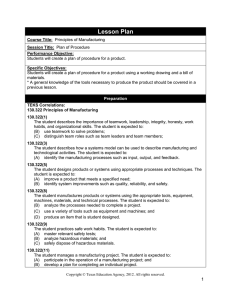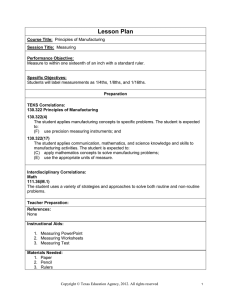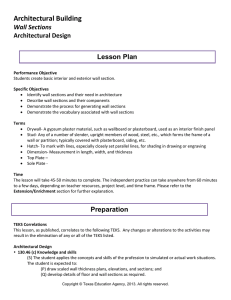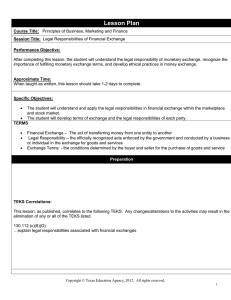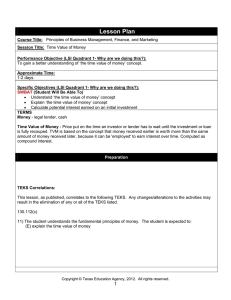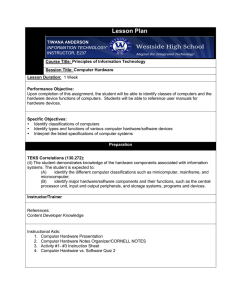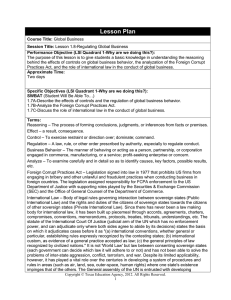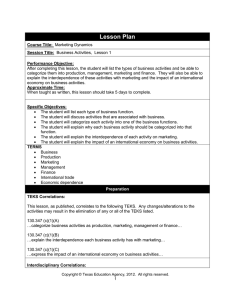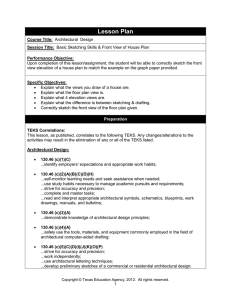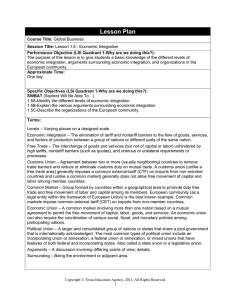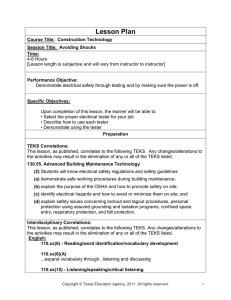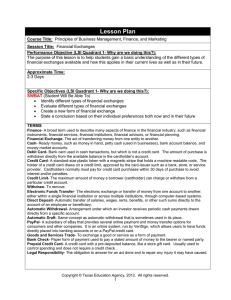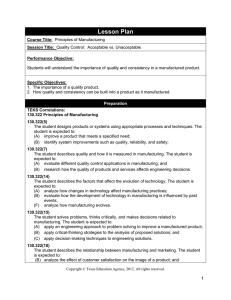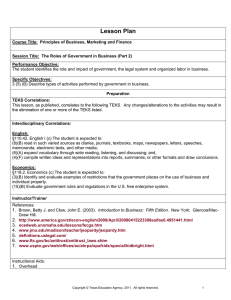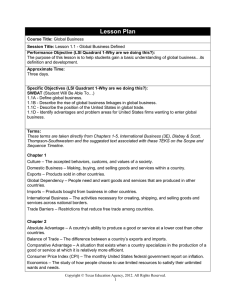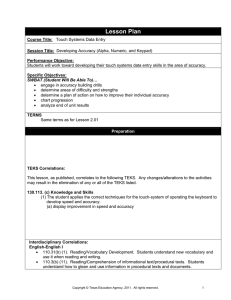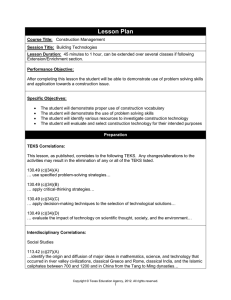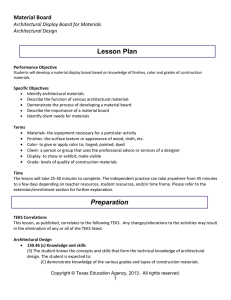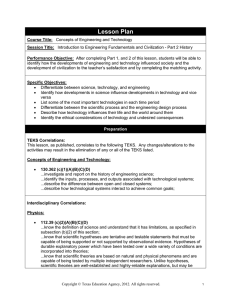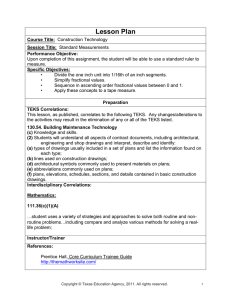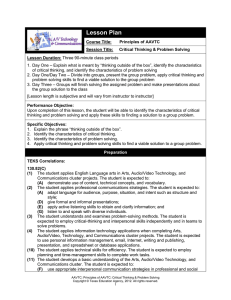Lesson Plan Balance Principles of Design - Balance Architectural Design
advertisement
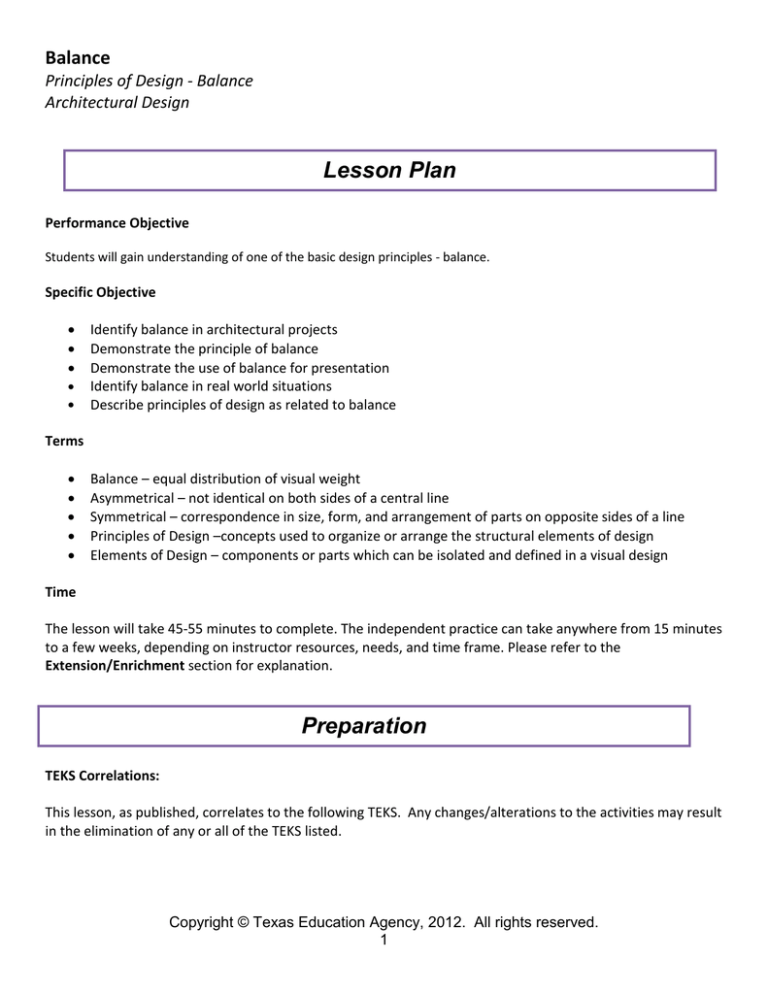
Balance Principles of Design - Balance Architectural Design Lesson Plan Performance Objective Students will gain understanding of one of the basic design principles - balance. Specific Objective • • • • • Identify balance in architectural projects Demonstrate the principle of balance Demonstrate the use of balance for presentation Identify balance in real world situations Describe principles of design as related to balance Terms • • • • • Balance – equal distribution of visual weight Asymmetrical – not identical on both sides of a central line Symmetrical – correspondence in size, form, and arrangement of parts on opposite sides of a line Principles of Design –concepts used to organize or arrange the structural elements of design Elements of Design – components or parts which can be isolated and defined in a visual design Time The lesson will take 45-55 minutes to complete. The independent practice can take anywhere from 15 minutes to a few weeks, depending on instructor resources, needs, and time frame. Please refer to the Extension/Enrichment section for explanation. Preparation TEKS Correlations: This lesson, as published, correlates to the following TEKS. Any changes/alterations to the activities may result in the elimination of any or all of the TEKS listed. Copyright © Texas Education Agency, 2012. All rights reserved. 1 Architectural Design 130.46(c) Knowledge and skills (7) The student begins exploration, development, and organization of ideas from the surroundings: (B) begin comparing and contrasting the use of architectural elements such as color, texture, form, line, space, value, and architectural principles such as emphasis, pattern, rhythm, balance, proportion, and unity in personal architectural projects and those of others using vocabulary accurately Interdisciplinary Correlations: World History Studies • • 113.42(c)(26)(A). Identify significant examples of art and architecture that demonstrate an artistic ideal or visual principle from selected cultures; 113.42(c)(26)(B). Analyze examples of how art, architecture, literature, music, and drama reflect the history of the cultures in which they are produced. Mathematical Models with Applications • 111.43(c)(6)(A). Use similarity, geometric transformations, symmetry, and perspective drawings to describe mathematical patterns and structure in architecture. Occupational Correlation (O*Net – www.onetonline.org): Job Title: Architects, Except Landscape and Naval O*Net Number: 17-1011.00 Reported Job Titles: Project Architect, Design Architect, Project Manager Tasks: • • • Consult with clients to determine functional or spatial requirements of structures. Prepare information regarding design, structure specifications, materials, color, equipment, estimated costs, or construction time. Direct activities of workers engaged in preparing drawings and specification documents. Soft Skills: Active Listening, Complex Problem Solving, Critical Thinking Accommodations for Learning Differences It is important that lessons accommodate the needs of every learner. These lessons may be modified to accommodate students with learning differences by referring to the files found on the Special Populations page of this website (cte.unt.edu). Copyright © Texas Education Agency, 2012. All rights reserved. 2 Preparation • • • Review and familiarize yourself with the terminology, materials, and principles of design. Have materials and documents ready for distribution prior to the start of the lesson. This lesson is intended to take 45-55 minutes. The Extension/Enrichment section of this lesson contains some ideas that can extend the lesson. The extent of the time frame given to this lesson can vary depending on your needs and resources. References D. K. Ching, F. (2007). Architecture: Form, space, and order. Hoboken, New Jersey: John Wiley and Sons. Instructional Aids • • • • Reference Book Sample balance design images Lesson Presentation Instructor Computer/Projection Unit Materials Needed • • • • Paper Pens, pencils Presentation boards (if needed) Construction paper Equipment Needed • • • Cutting tools Adhesives Surface to hang presentations (if needed) Learner Preparation • Discuss rules and guidelines for use of materials and tools. Copyright © Texas Education Agency, 2012. All rights reserved. 3 Introduction The main purpose of this lesson is to help students: • • • Understand there are existing principles of design (past) Understand balance as a principle of design (present) Utilize balance towards architectural projects (future) Show examples of balance in art or architecture. Allow students to ask questions and discuss pictures if they are unclear or curious. Ask students if they have ever seen art or visited an art museum. What were some of the outstanding characteristics about the art they noticed? Ask students if they have ever heard of the principles of design. Tell students that almost all art is based on some sort of basic design rules called the Principles of Design. These act as a “guide” to help artists’ layout and create pleasing art. These are also applied to the field of architecture. Architects use these similar rules when designing. These rules help to keep architecture pleasing to view and interact with. Today we are going to focus on one aspect of design - balance. Copyright © Texas Education Agency, 2012. All rights reserved. 4 Outline Outline (LSI Quadrant II): Instructors can use the software presentation and slides in conjunction with the following outline. MI OUTLINE I. II. III. IV. NOTES TO INSTRUCTOR Prior knowledge of the concept of balance Begin discussion over balance and what it means to students. Introduction of Principles of Design and Balance Use software presentation slides 3-4 to introduce concepts. Vocabulary and terms for Principles of Design and Balance Demonstration of proper use of tools and materials V. Use software presentation slides 5-10 to introduce concepts. Demonstrate the tools and materials available to you for cutting and gluing. Students will complete the Balance Project. Independent Practice Multiple Intelligences Guide Existentialist Interpersonal Intrapersonal Kinesthetic/ Bodily Logical/ Mathematical Musical/Rhythmic Naturalist Verbal/Linguistic Application Guided Practice (LSI Quadrant III): • Demonstrate to students how to create the items for the balance project. Model for students the proper techniques and safety for using the tools and materials. Independent Practice (LSI Quadrant III): • Have students create a layout using balance. Copyright © Texas Education Agency, 2012. All rights reserved. 5 Visual/Spatial Summary Review (LSI Quadrants I and IV): • Have students present their balance projects. • Ask students to reflect on their knowledge and recall/describe where they have seen balance used in design. Evaluation Informal Assessment (LSI Quadrant III): Any of the following can be used as informal assessments: • • • • Spot check for vocabulary terms Check progress on balance project Participate in balance project Present balance project Formal Assessment (LSI Quadrant III, IV): • Balance project using grading rubric Enrichment Extension/Enrichment (LSI Quadrant IV): • Have the students lay out a floor plan using balance as a guide. • Turn the balance design into a 3D model using materials of your choosing. Copyright © Texas Education Agency, 2012. All rights reserved. 6 Architectural Design Balance Lesson Handout Concepts: Principles of Design: concepts used to organize or arrange the structural elements of design Elements of Design: components or parts which can be isolated and defined in a visual design Vocabulary: Balance: equal distribution of visual weight Symmetrical: correspondence in size, form, and arrangement of parts on opposite sides of a line Asymmetrical: not identical on both sides of a central line Copyright © Texas Education Agency, 2012. All rights reserved. 7 Architectural Design Balance Lesson Test/Project Project: Students will use the following materials: Construction paper Glue Scissors Students will cut geometric shapes out of colored construction paper. They will then use their shapes to lay out a design that displays balance. Students will then present their project to the class and explain the visual balance in the design. Test: Students will be graded using the assigned rubric. Extension: Students can create a project for Asymmetrical and Symmetrical Balance. Copyright © Texas Education Agency, 2012. All rights reserved. 8 Rubric Template Task Statement: Balance Task Assignment: Balance Project Criteria Concepts/Skills to be Assessed Followed directions (Possible 4 points) Vocabulary usage Novice 1 Criteria Categories (Novice to Exemplary) Developing Accomplished 2 3 Did not demonstrate understanding and did not follow directions for lesson Understood and followed some directions for lesson Understood and followed most directions for lesson Understood and followed all directions for lesson Did not use proper vocabulary Used some vocabulary Properly used most vocabulary Accurately and thoroughly used vocabulary Sloppy and unclean Somewhat clean and accurate Mostly clean and accurate Clean and accurate Understanding of balance is not shown Some understanding of balance is shown Mostly, understanding of balance is shown An accurate understanding of balance is shown Sloppy and unbalanced Some accurate, many incorrect pieces Mostly accurate, mostly clean, some incorrect pieces Accurate, clean, and balanced (Possible 4 points) Gluing Exemplary 4 (Possible 4 points) Balance Idea (Possible 4 points) Craftsmanship (Possible 4 points) A = 20 – 17 points Total Points: 20 B = 16 – 13 points C = 12 – 9 points D = 8 – 5 points F = 4 – 1 points Copyright © Texas Education Agency, 2012. All rights reserved. 9 Points Earned
